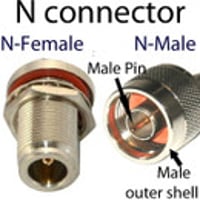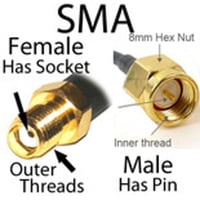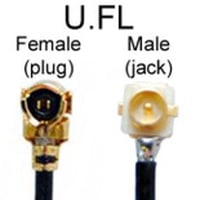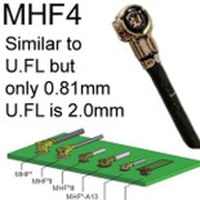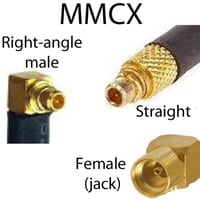Adapters with N Type Connectors
Type N Connector Couplers, Gender Changers, Adapters
Nickel-plated for corrosion protection, weatherproofing, outdoor durability
The main N connector adapters according to their applications:
- N to SMA adapters: This adapter combination is used in cellular networking. It facilitates connections for antennas and base station components.
- N to RP-SMA adapter: This adapter combination is used in wireless networking. Use them to install robust N connector outdoor WiFi antennas. for outdoor Wi-Fi coverage.
- N to MMCX adapter: Use this adapter to connect a larger antenna to a PCB-mounted MMCX connector via the more rugged and easy-to-handle N connector.
- N to TNC adapter: N to TNC adapters are often used in outdoor wireless networking applications or test environments.
- N to U.FL adapter: A pigtail U.FL to N connector adapter protects a PCB-mounted U.Fl connector from the repeated connection and disconnection of external antennas.
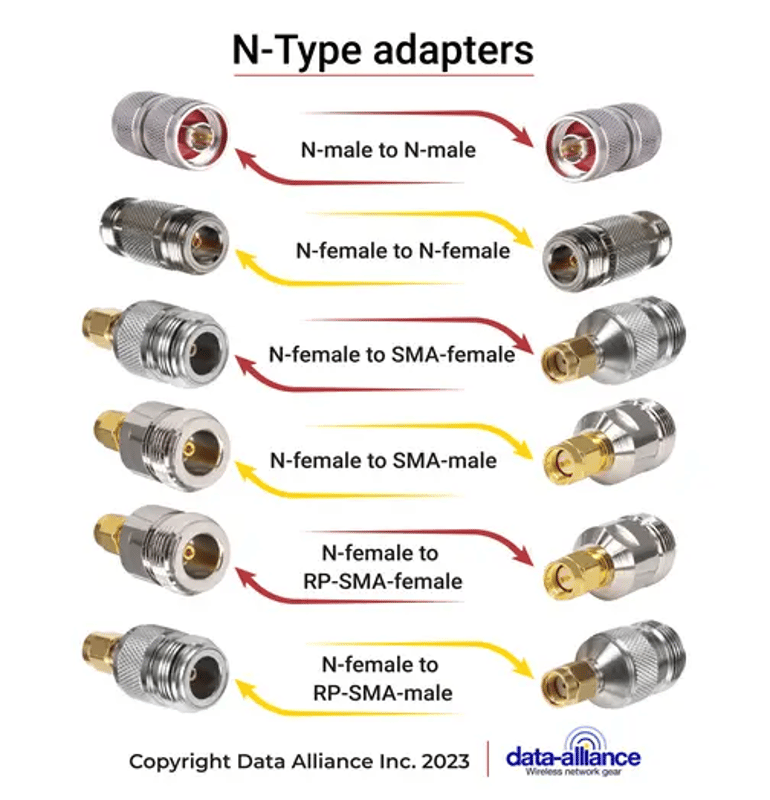
N connector adapters are one of the most important classes of radio frequency adapters as they are often used to bring radio frequency connectivity outdoors. They operate as passive coaxial cable components bridging the mechanical and electrical connection between a Type N connector and either an N connector of the opposite gender or differing geometry or an RF connector of a different type. The two main classes of N connector adapters are:
- In-series N connector adapters: in-series adapters have the same type of connector on both sides. They may be male to male, male to female, female to female, and can be straight or right-angled.
- Between-series N connector adapters: between-series adapters have an N adapter on one side and a different type of adapter on the other side.
Type N connector adapters are available as either solid units that form a connection between each type of connector on either size or pigtail adapters with the two classes of connector (usually with marked size disparity) separated by a short length of coax.
Quality N connector adapters maintain the electrical connection with matched impedance. Discontinuities and signal loss should be kept to an absolute minimum through expert machinery and fabrication.
Radio frequency adapters with an N connector are passive coaxial cable components that are capable of facilitating a mechanical and electrical connection between an N connector and another, distinct, type of radio frequency connector. They can be solid units that form a connection between each type of connector on either size or be a pigtail adapter with the two classes of connector separated by a short length of coax. A good quality N connector adapter should maintain the electrical connection and have fully matched impedance with discontinuities and signal loss kept to an absolute minimum. Adapters will also vary in gender and geometry to be able to make the required connection. N connector adapters also can be broadly divided into:
- In-series N connector adapters: in series adapters have the same type of connector on both sides. They may be male to male, male to female, female to female, and can be straight or right-angled.
- Between-series N connector adapters: between series adapter have an N adapter on one side and a different type of adapter (eg. SMA, RP-TNC, BNC) on the other side.
Why are N-type connector adapters important?
The N connector is widely used because of its size, ruggedness, and consistent performance at high frequencies. These connectors are often selected for larger diameter, low loss coax, and high voltage rating for higher gigahertz frequencies also sets it apart for applications where robust power handling and increased data transfer are needed. N connectors are capable of being used to terminate a range of medium caliber and mini coaxial cables. It is easy to handle and forms a physically and electrically reliable connection that is available in a range of configurations including:
- Straight and right-angle plugs
- Bulkhead, panel mount, and receptacle jacks
It is also a common antenna connector, especially for vehicle-mounted and rapid deployment radio devices as it is larger and heavier than other types of antenna connectors like SMA and TNC. Its size is also what often necessitates the need for an adapter. As a larger connector, not all radio devices have the room to accommodate N-type connectors, so adapters can facilitate the connection of an N connector antenna to a smaller caliber connector.
When connecting an N-type connector adapter, consideration must be made to the electrical specifications and ratings of the connector type on the other end of the connector. Though the connector adapter will be impedance matched, the voltage rating, frequency range, and other parameters may differ and need to be accommodated.
Key applications for the N-type connector adapter
N-type connector adapters are likely to be needed in the many civil, defense (radar and Satcom), and industrial applications.
- Instrumentation: Their robust panel mounting and heavy caliber yet precision cable assemblies mean that they are of particular use in instrumentation or testing and measurement applications. Between-series N connector adapters can be used to connect miniature connector cabling, antennas, and radio devices to a larger and more resilient panel-mounted and benchtop N connection that will withstand repeated connection and disconnection without loss of performance.
- Radio devices: Both in-series and between series N-type connector adapters can support seamless multi gigahertz connectivity in a wide range of radio devices. The range of conformations available, including jack-to-jack and plug-to-jack means that cabling and N-type connector antennas for broadcast equipment can be readily installed via alternate connectors.
- Wireless Local Area Networking: As a larger, hand-tightened 50 Ohm connector, the N connector is increasingly prevalent in consumer-facing wireless networking. The connectors weatherproof connection is also of use in outdoor antenna and base station installations. High-quality nickel-plated (corrosion-resistant) brass bodies and contacts on both sides of the connector ensure sound electrical performance needed for networks with high data throughput.
- Lightning surge protection: The voltage rating of the N-type connector means that is the connector of choice for protecting cellular and wireless networking antenna installations from damaging voltage surges caused by lightning strikes. N connector adapters can also be used to integrate lightning surge protectors so that they can be connected to miniature and even micro connectors where necessary.
Tee connector Adapters for N-Type Cables
A T-connector can connect three coaxial cables. The connector points may vary in gender. They can be used to connect two antennas to a single feed line or split radio frequency energy from the feedline into to divert it to separate radio frequency circuits or devices.
Summary in Conclusion:
N-type connector adapters are necessary for a broad range of radio frequency circuits and wireless networks due to the unique specifications of the N connector. For wireless and cellular networking where SMA and RP-SMA connectors predominate, an N-type connector adapter introduces the advantageous features of this rugged connector into otherwise miniature caliber radio frequency circuits.
LEARN MORE:

